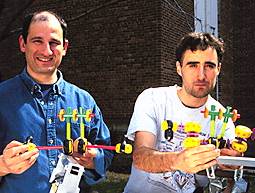10 March 2000
Micro robots wanted for police and military duty
by Kate Melville
 Ever heard of Defense Advanced Research Project Agency, DARPA ? Well in effect they are the people who brought us what we now call the Internet and they are continuing to invest in science, although it's hard to see them coming up with a new invention to top the web.
Ever heard of Defense Advanced Research Project Agency, DARPA ? Well in effect they are the people who brought us what we now call the Internet and they are continuing to invest in science, although it's hard to see them coming up with a new invention to top the web.
One of the projects DARPA is currently supporting is work by a team at Michigan State University's College of Engineering, who are developing reconfigurable micro-robots for use in military, intelligence and law enforcement situation. Essentially the US defense department wants to lower the risk to humans in dangerous situation as their national psyche can't abide the image of body bags (a bit odd for such a 'warrior' culture).
Anyway, the team at MSU are trying to build very small robots (less than five centimeters in diameter) that have microphones, cameras and a range of sensors (infrared, thermal, chemical etc) that can overtly or covertly enter hazardous locations and then send information back that can be used to help plan 'resolution strategies' (read to negotiate or shoot).
According to Lal Tummala, professor of electrical engineering and manufacturing, and project coordinator, "the robots could be dropped by helicopter or shot like bullets into a building. From there, they could go about their business, gathering information without notice."
Some of the design issues in trying to design and build these micro robots are things like:
The need for inexpensively manufacturing so that units can be widely deployed and are expendable
High maneuverability and the ability to access very small spaces
Communication between robots allowing coordinated actions
Minimum power usage
MSU's final model was a bipedal caterpillar-like robot that could both move along floors and rough terrain as well as being able to climb vertically using its suction cup feet.
Two of key features of MSU robots are:
Suction cup feet which the team refers to as a "smart robotic foot" or SRF. Each SRF consists of a suction cup, a pressure sensor and a vacuum pump. The sensor, mounted inside the suction cup, signals whether pressure is at or below atmospheric pressure, if below the vacuum pump switches on, creating vacuum suction
Diamond coatings have also been used to reduce friction between components, lengthening the battery life of each robot.
However while all these physical advances sound impressive it may in the end boil down to a question of software as to whether these micro robots actually work effectively. The range of software controls include:
Task controllers to maintain stability control direction of movement
Cognitive development tools
Hybrid task planners to provide the main software interface to control the robot
Swarming communications algorithms
Developmental algorithms that allows the robot to 'learn'.
For their intended owners these micro robots may be revolutionary but for most of us the closest we will probably ever get to these 21st century crime fighters is via TV shows like 'Cops', unless of course you are planning a career in organized crime or international terrorism?
